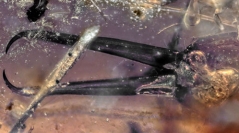Lacewing larvae in the Cretaceous were more diverse in appearance than they are today, best documented by numerous fossils preserved in amber. One morphotype of an unusual larva from about 100 Ma old Kachin amber (Myanmar) was formally recognised as a distinct group called Ankyloleon. The original description erected a single formal species, Ankyloleon caudatus. Yet, it was indicated that among the five original specimens, more species were represented. We here report five new specimens. Among these is the so far largest as well as the so far smallest specimen. Based on this expanded material we can estimate certain aspects of the ontogenetic sequence and are able to recognise a second discrete species, Ankyloleon caroluspetrus sp. nov. We discuss aspects of the biology of Ankyloleon based on newly observed details such as serrations on the mandibles. Long and slender mouthparts, legs and body together with a weakly expressed outer trunk segmentation provide indications for a lifestyle hunting for prey in more confined spaces. Still many aspects of the biology of these larvae must remain unclear due to a lack of a well comparable modern counterpart, emphasising how different the fauna of the Cretaceous was.


 European Journal of Taxonomy
908 (135) - Pages 135-154
European Journal of Taxonomy
908 (135) - Pages 135-154